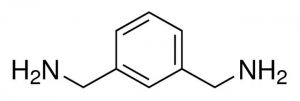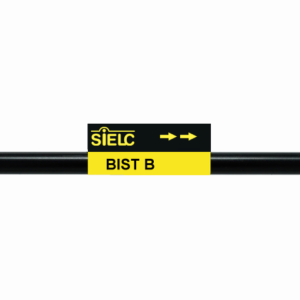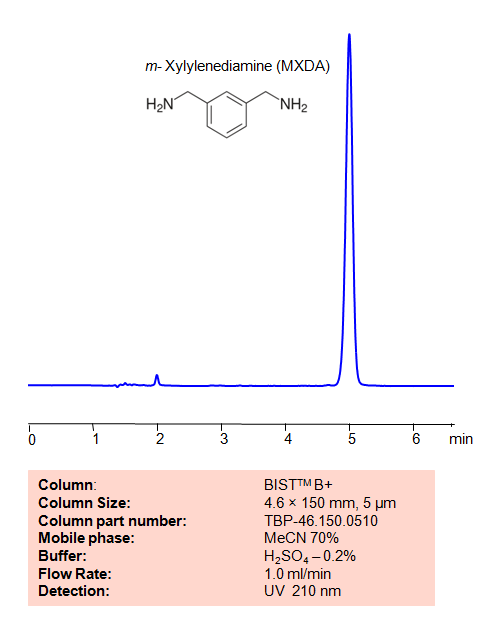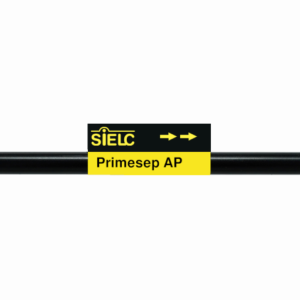| CAS Number | 1477-55-0 |
|---|---|
| Molecular Formula | C8H12N2 |
| Molecular Weight | 136.198 |
| InChI Key | FDLQZKYLHJJBHD-UHFFFAOYSA-N |
| LogP | -0.3 |
| Synonyms |
|
Applications:
HPLC Method for Separation of Amines on BIST B and BIST B+ Columns
March 23, 2023
HPLC Method for Separation of Amines on BIST B and BIST B+ Columns by SIELC Technologies
Separation type: Bridge Ion Separation Technology, or BIST™ by SIELC Technologies
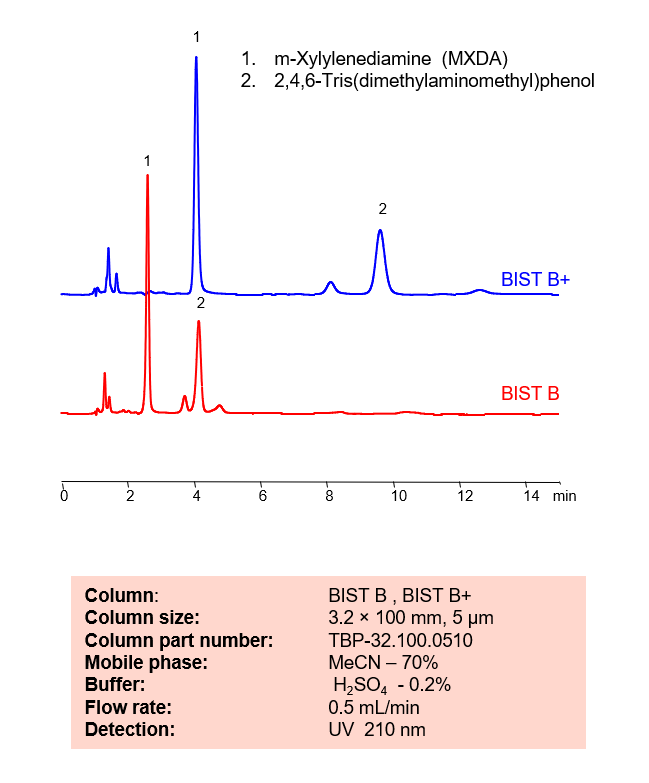
m-Xylylenediamine (MXDA) is a popular curing agent used on epoxy resins. 2,4,6-Tris(dimethylaminomethyl)phenol is another amine-based curing agent used on epoxy resins. Using SIELC’s newly introduced BIST™ method, these amines can be retained and separated on a positively charged, anion-exchange BIST™ B or BIST™ B+ column. The surface chemistry of BIST™ B+ columns are designed to have stronger ionic retention capabilities, resulting in the marked increase in retention compared to BIST™ B columns.
There are two keys to this retention method: 1) a multi-charged, negative buffer, such as Sulfuric acid (H2SO4), which acts as a bridge, linking the positively charged dipeptide to the positively charged column surface and 2) a mobile phase consisting mostly of organic solvent (such as MeCN) to minimize the formation of a solvation layer around the charged analytes. Using this new and unique analysis method, these two amines can be UV detected at 210 nm.
High Performance Liquid Chromatography (HPLC) Method for Analysis of Amines
Condition
| Column | BIST B, 3.2 x 100 mm, 5 µm, 100 A |
| Mobile Phase | MeCN – 70% |
| Buffer | H2SO4 – 0.2% |
| Flow Rate | 0.5 ml/min |
| Detection | UV 210 nm |
| Peak Retention Time |
Description
| Class of Compounds | Amines |
| Analyzing Compounds | m-Xylylenediamine, 2,4,6-Tris(dimethylaminomethyl)phenol |
Application Column
m-Xylylenediamine

HPLC Method for Separation of Amines in Non Aqueous MP on BIST B+ Column
March 1, 2023
HPLC Method for Separation of of Amines in Non Aqueous MP on BIST B+ by SIELC Technologies
Separation type: Bridge Ion Separation Technology, or BIST™ by SIELC Technologies
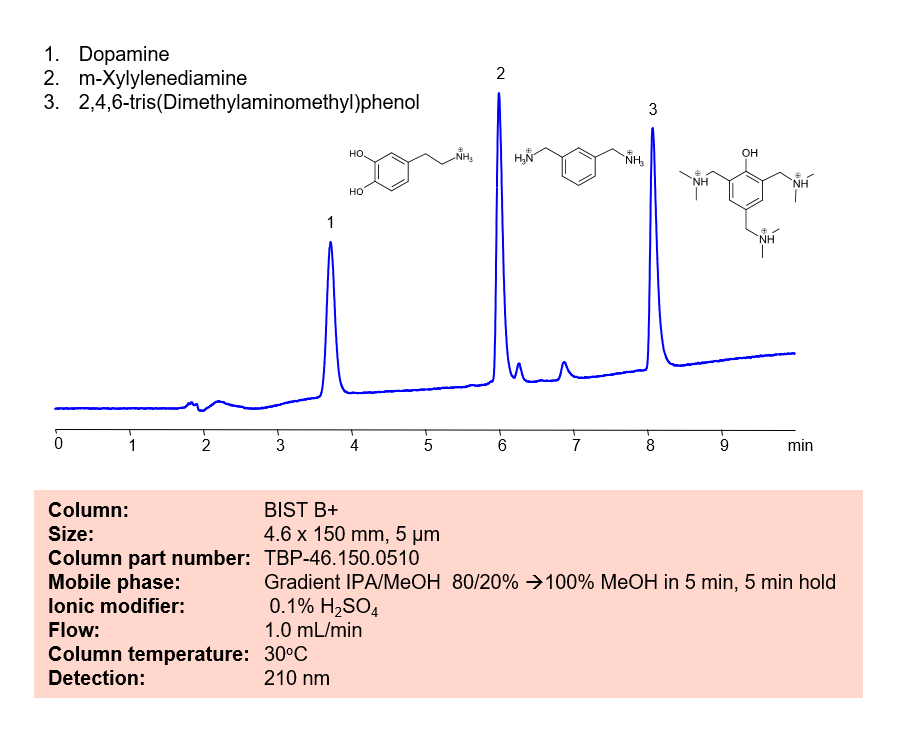
Dopamine is a key neurotransmitter and medical stimulant used to treat low blood pressure, low heart rate, and heart attacks. m-Xylylenediamine (MXDA) is a popular curing agent used on epoxy resins. 2,4,6-Tris(dimethylaminomethyl)phenol is another amine-based curing agent used on epoxy resins. Using SIELC’s newly introduced BIST method, these 3 amines can be retained on a positively-charged anion-exchange BIST B+ column. There are two keys to this retention method: 1) a multi-charged, negative buffer, such as Sulfuric acid (H2SO4), which acts as a bridge, linking the positively-charged analytes to the positively-charged column surface and 2) a mobile phase consisting mostly of less polar organic solvent (such as IPA) to minimize the formation of a solvation layer around the charged analytes. This method uses an entirely non-aqueous mobile phase to drive BIST retention. The gradient starts with a high concentration of the less polar IPA to generate the initial BIST retention and progresses to the more polar MeOH to elute the longer-retaining amines in a reasonable time. Using this new and unique analysis method, these 3 amines can be retained and UV detected at 210 nm.
High Performance Liquid Chromatography (HPLC) Method for Analysis of of Amines in Non Aqueous MP
Condition
| Column | BIST B+, 4.6 x 150 mm, 5 µm, 100 A |
| Mobile Phase | Gradient IPA/MeOH- 80/20% to 100% MeOH, 5 min , 5 min hold |
| Buffer | H2SO4 – 0.2% |
| Flow Rate | 1.0 ml/min |
| Detection | UV 210 nm |
| Peak Retention Time | 3.52 min, 6.12 min, 8.57 min |
Description
| Class of Compounds | Amines |
| Analyzing Compounds | Dopamine, m-Xylylenediamine, 2,4,6-Tris(dimethylaminomethyl)phenol |
Application Column
Dopamine
m-Xylylenediamine

HPLC Method For Analysis of Xylylenediamine on BIST B+ Column
June 15, 2022
Separation type: Bridge Ion Separation Technology, or BIST™
High Performance Liquid Chromatography (HPLC) Method for Analysis of m- Xylylenediamine (MXDA)
HPLC Method for Analysis of m-Xylylenediamine on a BIST B Column.
m-Xylylenediamine (MXDA) is a popular curing agent used on epoxy resins. Using SIELC’s newly introduced BIST method, MXDA, which protonates in water, can be retained on a positively-charged anion-exchange BIST B column. There are two keys to this retention method: 1) a multi-charged, negative buffer, such as Sulfuric acid (H2SO4), which acts as a bridge, linking the positively-charged MXDA analytes to the positively-charged column surface and 2) a mobile phase consisting mostly of organic solvent (such as MeCN) to minimize the formation of a solvation layer around the charged analytes. Using this new and unique analysis method, MXDA can be retained and UV detected at 210 nm.
| Column | BIST B+, 4.6×150 mm, 5 µm, 100A |
| Mobile Phase | MeCN/H2O – 70/30% |
| Buffer | H2SO4 – 0.2 % |
| Flow Rate | 1.0 ml/min |
| Detection | UV, 210 nm |
| Class of Compounds |
Drug, Basic, Hydrophobic, Ionizable, Zwitterionic |
| Analyzing Compounds | m-Xylylenediamine (MXDA) |
Application Column
BIST B
BIST™ columns offer a unique and effective way to achieve separations that were traditionally challenging or even impossible with other HPLC columns. With the use of a special mobile phase, these ion exchange columns provide very strong retention for analytes with the same charge polarity as the stationary phase, unlocking new chromatography applications. What makes BIST™ columns stand out is their proprietary surface chemistry, which results in superior selectivity, resolution, and sensitivity. These columns offer a simple, efficient solution for a variety of analytical challenges, making them an excellent choice for researchers and analysts across many different fields. To learn more about the technology that powers BIST™ columns and to explore related applications, check out https://BIST.LC.
Select optionsBIST B+
BIST™ columns offer a unique and effective way to achieve separations that were traditionally challenging or even impossible with other HPLC columns. With the use of a special mobile phase, these ion exchange columns provide very strong retention for analytes with the same charge polarity as the stationary phase, unlocking new chromatography applications. What makes BIST™ columns stand out is their proprietary surface chemistry, which results in superior selectivity, resolution, and sensitivity. These columns offer a simple, efficient solution for a variety of analytical challenges, making them an excellent choice for researchers and analysts across many different fields. To learn more about the technology that powers BIST™ columns and to explore related applications, check out https://BIST.LC.
Select optionsm-Xylylenediamine

HPLC Method for Analysis of m-Xylylenediamine (MXDA) on BIST™ B+ Column
June 15, 2022
Separation type: Bridge Ion Separation Technology, or BIST™
BIST Ionic Modifier Preparation
High Performance Liquid Chromatography (HPLC) Method for Analysis of m- Xylylenediamine (MXDA)
HPLC Method for Analysis of m-Xylylenediamine on a BIST™ B Column.
m-Xylylenediamine (MXDA) is a popular curing agent used on epoxy resins. Using SIELC’s newly introduced BIST™ method, MXDA, which protonates in water, can be retained on a positively-charged anion-exchange BIST™ B column. There are two keys to this retention method: 1) a multi-charged, negative buffer, such as Sulfuric acid (H2SO4), which acts as a bridge, linking the positively-charged MXDA analytes to the positively-charged column surface and 2) a mobile phase consisting mostly of organic solvent (such as MeCN) to minimize the formation of a solvation layer around the charged analytes. Using this new and unique analysis method, MXDA can be retained and UV detected at 210 nm.
| Column | BIST™ B+, 4.6×150 mm, 100A |
| Mobile Phase | MeCN – 80% |
| Buffer | H2SO4 – 0.2% |
| Flow Rate | 1.0 ml/min |
| Detection | UV 210nm |
| Class of Compounds | Amine, Aliphatic amine |
| Analyzing Compounds | m-Xylylenediamine (MXDA) |
Application Column
BIST B
BIST™ columns offer a unique and effective way to achieve separations that were traditionally challenging or even impossible with other HPLC columns. With the use of a special mobile phase, these ion exchange columns provide very strong retention for analytes with the same charge polarity as the stationary phase, unlocking new chromatography applications. What makes BIST™ columns stand out is their proprietary surface chemistry, which results in superior selectivity, resolution, and sensitivity. These columns offer a simple, efficient solution for a variety of analytical challenges, making them an excellent choice for researchers and analysts across many different fields. To learn more about the technology that powers BIST™ columns and to explore related applications, check out https://BIST.LC.
Select optionsBIST B+
BIST™ columns offer a unique and effective way to achieve separations that were traditionally challenging or even impossible with other HPLC columns. With the use of a special mobile phase, these ion exchange columns provide very strong retention for analytes with the same charge polarity as the stationary phase, unlocking new chromatography applications. What makes BIST™ columns stand out is their proprietary surface chemistry, which results in superior selectivity, resolution, and sensitivity. These columns offer a simple, efficient solution for a variety of analytical challenges, making them an excellent choice for researchers and analysts across many different fields. To learn more about the technology that powers BIST™ columns and to explore related applications, check out https://BIST.LC.
Select options
Analysis of m-Xylylenediamine (MXDA)
February 15, 2012
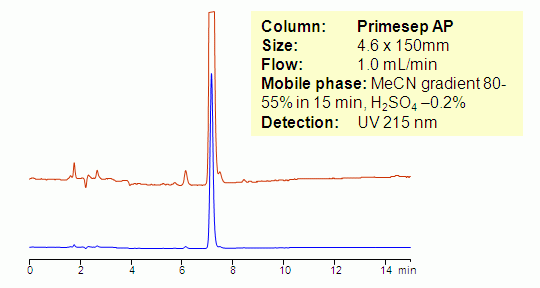
| Column | Primesep AP, 4.6×150 mm, 5 µm, 100A |
| Mobile Phase | MeCN/H2O |
| Buffer | H2SO4 – 0.2 % |
| Flow Rate | 1.0 ml/min |
| Detection | UV, 215 nm |
| Class of Compounds |
Drug, Basic, Hydrophobic, Ionizable, Zwitterionic |
| Analyzing Compounds | m-Xylylenediamine (MXDA) |
Application Column
Primesep AP
The Primesep family of mixed-mode columns offers a wide variety of stationary phases, boasting unprecedented selectivity in the separation of a broad array of chemical compounds across multiple applications. Corresponding Primesep guard columns, available with all stationary phases, do not require holders. SIELC provides a method development service available to all customers. Inquire about our specially-tailored custom LC-phases for specific separations.
Select optionsXylylenediamine
m-Xylylenediamine

